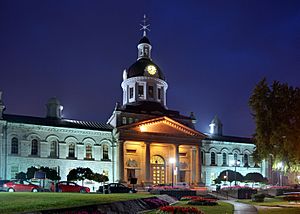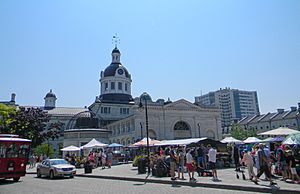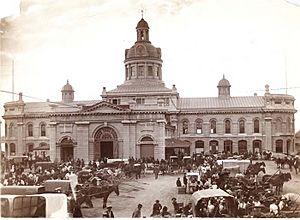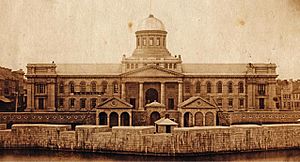Kingston City Hall (Ontario) facts for kids
Quick facts for kids Kingston City Hall |
|
|---|---|

Kingston City Hall, 2008
|
|
| Location | Kingston, Ontario, Canada |
| Built | 1844 |
| Original use | City hall, market, custom house, post office, police station, jail, and other uses |
| Current use | City hall |
| Architect | George Browne |
| Architectural style(s) | Neoclassical |
| Governing body | City of Kingston |
| Designated | 1961 |
Kingston City Hall is where the city's local government works in Kingston, Ontario, Canada. It takes up a whole city block and faces Lake Ontario in downtown Kingston. The building is very noticeable with its Neoclassical style, featuring a special round base (called a tholobate) and a large dome.
The city hall was finished in 1844. Its large size and fancy design showed how important Kingston was at the time. Back then, Kingston was the capital of the Province of Canada. George Browne was chosen as the architect in 1841. Many people thought this building was one of his best designs.
In 1961, Kingston City Hall was named a National Historic Site of Canada. This means it's a very important place in Canadian history.
Contents
Building History
On April 18, 1840, a big fire destroyed much of downtown Kingston. This included the market area and the old city offices. The mayor, John Counter, suggested building a new market and a new city hall. Since Kingston was the capital of the new Province of Canada, the new city hall needed to look grand and important.
Architect George Browne, who had moved to Kingston with the government, won the design competition. He drew the plans and started leading the construction. However, William Coverdale finished the building after Browne left the project. The first stone was laid on June 5, 1843, by Governor General Charles Metcalfe. The building was completed by November 1844.
The new city hall was built from limestone and shaped like a "T". It included a new market building that stretched west towards King Street. This part of the city hall was called the market "shambles." It was used by sellers of fruits, vegetables, and meat. This market wing also had a clock tower. In 1865, a fire destroyed this wing. It was rebuilt smaller and without the clock tower. The clock was then moved to the main dome. Another fire in 1908 destroyed the main dome, which was then rebuilt with a new clock.
When the government moved the capital to Montreal in May 1844, Kingston faced money problems. The city council worried about paying for the big new building. So, they started renting out parts of it. Different groups rented space, including the post office, customs offices, and even a bank. The west wing was used for talks, meetings, and parties.
The front entrance had a special porch called a portico. This porch was removed in 1956 because it was falling apart. But it was put back in 1966. In 1973, to celebrate Kingston's 300th birthday, the inside of the building was updated and made to look like it did originally.
Memorial Hall, in the north wing, has twelve beautiful stained glass windows. These windows honor those who fought in battles during the First World War.
Sir John A. Macdonald, who became Canada's first prime minister, lay in state here after he died on June 6, 1891.
Police Headquarters at City Hall
Kingston's police force started their main office in the basement of City Hall when it opened in 1844. This area had a large room, four jail cells, and the Police Court. In the early 1900s, the police offices moved to the main floor.
In 1952, the police offices moved into two floors of the attached Market Building, which had been updated. Police holding cells were on the main floor, while the main offices and court were on the second floor. As the police force grew, they needed more space. So, the police headquarters moved to a separate building in 1972. They have since moved to an even larger location.
Springer Market Square
Springer Market Square is located right behind City Hall. It hosts a seasonal farmers' market called the Kingston Public Market. You can find it there on Tuesdays, Thursdays, and Saturdays from April to November. In the past, the market ran all year round. It is the oldest public market in the province of Ontario. An antiques market also takes place in the square on Sundays.
The square was part of Kingston's first town plan in 1784. An informal market started there in 1788. It was the only place in Kingston where farmers could sell their goods. The Kingston Public Market was officially started by the city in 1801. It was the main place for buying and selling in the city. Over time, public buildings, hotels, and shops grew up around the square, including Kingston City Hall in 1844.
In 1758, British soldiers used this site when they attacked the French Fort Frontenac during the Battle of Fort Frontenac. The square was also where important announcements were made. For example, the Constitutional Act 1791, which created Upper Canada, was announced here. The start of the War of 1812 was also announced here. In 1867, Canadian Confederation was proclaimed in the square. Soldiers also gathered here before going to fight in the North-West Rebellion and the First and Second World Wars.
Between 2005 and 2007, the square was updated. It now has an outdoor skating rink and small outdoor stages. In 2008, the square was renamed "Springer" Market Square. This was to thank the Springer family for donating $1 million to help pay for the square's improvements.
Confederation Park
Confederation Park is next to Kingston City Hall and separates it from the waterfront. This park was created in 1967 on land that used to be industrial. It has a large arch with a fountain and the Confederation Basin Marina. An old train station, which was once the end point for the Kingston and Pembroke Railway, is now a visitor information center. A restored historic train, called the "Spirit of Sir John A.", reminds people of Kingston's past in making trains.
Market Battery
A fort called the Market Battery was built on the waterfront right in front of City Hall, where Confederation Park is now. It was finished in 1848 because of disagreements between the United States and Great Britain during the Oregon Crisis. The Market Battery was one of several forts built in Kingston at that time. It had a thick outer wall in the harbor with openings for cannons. An inner wall completed the fort's enclosure. In the 1870s, after British troops left Kingston, the inner wall was removed, and the area became a park. The large outer wall was removed in 1885. A part of the battery wall has been rebuilt to show what the site looked like.





